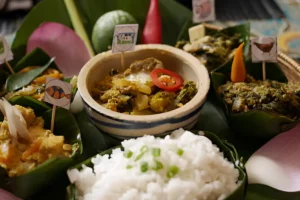Embark on a culinary adventure in Bangkok in 2025, where food lovers can savour must-try dishes that showcase the city’s vibrant food culture. Renowned for its bustling street food scene, Bangkok also boasts a growing number of Michelin-starred dining options, offering something for every palate. The city’s rich tapestry of flavours reflects its diverse regions, cultures, and traditions, making it a paradise for food enthusiasts. This guide highlights the top 10 must-try dishes in Bangkok, blending iconic street eats, regional specialities, vegetarian options, and sweet treats. Whether you’re a spice aficionado, a dessert lover, or someone exploring plant-based Thai cuisine, these dishes are sure to ignite your taste buds and deepen your appreciation for Thailand’s gastronomic heritage. Dive in to learn more about the incredible depth of Thai culinary traditions. `Learn more about Thai culinary heritage.
Top 10 Must-Try Dishes in Bangkok
Dive into these ten must-try dishes in Bangkok. Each is a masterpiece of Thai culinary art. This section provides detailed descriptions. It includes regional origins, cultural significance, preparation insights, and specific locations. You can savour them authentically.
Steamed Shrimp and Pork Dumplings (Khanom Jeeb)

Description: These delicate dumplings are a symphony of flavours. They feature tender shrimp and juicy pork. The filling blends garlic, cilantro, and white pepper. Everything is encased in a thin, translucent wrapper. Steamed to perfection, each bite bursts with savoury goodness. A soy-vinegar dipping sauce often enhances it. Try this gem among must-try dishes in Bangkok.
Region: Central Thailand, with deep roots in Chinese influences. These date to the 19th century Teochew community.
Cultural Significance: Khanom Jeeb reflects Bangkok’s historical melting pot. Chinese culinary techniques merged with local Thai ingredients.
Preparation Insight: Vendors meticulously fold each dumpling by hand, and this skill is passed down through generations. As a result, it ensures uniformity and flavour infusion, making each bite a testament to tradition.
Where to Try: For an authentic experience, head to Ratchawat Market (Ratchawat Road, 40-70 baht/1.20−1.20−2 USD). To enjoy the freshest batches, visit in the early morning, as these come from family-run stalls. Alternatively, try Jay Fai (Salad Market, 327 Maha Chai Road), where you’ll find a Michelin-recognized version with richer filling for 150-200 baht/4.50−4.50−6 USD.
Why Must-Try: This dish is a beloved street food that offers a perfect balance of flavours, making it appealing to both novices and seasoned food lovers. Moreover, its combination of tradition, skill, and taste makes it a standout in Bangkok’s culinary scene.
Grilled Meat Skewers with Satay and Cucumber Relish (Moo Satay)

Description: Marinated pork skewers soak in a flavorful blend of coconut milk and spices, including turmeric, coriander, and palm sugar. After marinating, they are grilled over charcoal until smoky and tender, creating a mouthwatering aroma.
To complement the skewers, a zesty cucumber relish is served alongside, while a rich peanut sauce adds an extra layer of flavour. Ultimately, the dish masterfully combines sweet, savoury, and tangy notes, ensuring every bite is an absolute delight.
Region: Central and Southern Thailand, influenced by Malay and Indian routes, which introduced satay to the region.
Cultural Significance: Moo Satay symbolizes Thailand’s adaptability, blending Southeast Asian grilling techniques with local spices to create a unique culinary experience.
Preparation Insight: The marinade soaks for hours, allowing deep flavour infusion. The relish combines fresh cucumbers, shallots, and a touch of chilli for a cooling contrast.
Where to Try: For a classic experience, visit Yaowarat Road in Chinatown (50-90 baht/1.50−1.50−2.50 USD), where night market stalls near the main strip excel. Alternatively, try Chatuchak Weekend Market (Kamphaeng Phet 2 Road, 60-100 baht/2−2−3 USD), offering a variety of satay vendors.
Why Must-Try: This street food classic delivers layered flavours and is perfect for exploring Thailand’s vibrant outdoor kitchens.
Mango and Sticky Rice (Khao Neiw Mamuang)

Description: This iconic dessert features ripe, golden mango slices. They sit atop glutinous sticky rice. A luscious coconut milk sauce drenches it. Palm sugar sweetens it, with a pinch of salt sprinkled. The contrast between juicy fruit and creamy rice is divine.
Region: Central Thailand, though popular nationwide. Its origins are tied to rural rice-growing communities.
Cultural Significance: A celebration of Thailand’s agricultural abundance. It often serves during festivals like Songkran.
Preparation Insight: The sticky rice is soaked overnight and steamed. It mixes with coconut milk. The milk heats to the right temperature. This avoids curdling. The process is meticulous.
Where to Try: Or Tor Kor Market (Kamphaeng Phet 3 Road, Chatuchak, 60-80 baht/$2-$2.50 USD). Vendors use the freshest seasonal mangoes. Also check out Mango Tango (Sukhumvit Soi 23, 100-150 baht/$3-$4.50 USD). It offers a modern twist.
Why Must-Try: A tropical treat that embodies Thailand’s sweet side. It’s irresistible to dessert lovers.
Vegetarian Pad Thai

Description: A vibrant stir-fry of rice noodles dances with crisp bean sprouts. Shredded carrots and tofu join in. A tangy tamarind sauce coats them. It has a hint of chilli and lime. It’s vegan when eggs are omitted. The dish bursts with umami and freshness.
Region: Adapted from Central Thailand’s iconic Pad Thai. It was promoted as a national dish in the 1930s.
Cultural Significance: Reflects Thailand’s modern adaptation to global trends. It makes Thai cuisine accessible to vegetarians.
Preparation Insight: The wok hei (breath of the wok) is key. High-heat stir-frying achieves it. Vendors add roasted peanuts for crunch. This happens at the last moment.
Where to Try: Victory Monument food stalls (near the monument, 50-80 baht/$1.50-$2.50 USD). Request a veggie version from vendors with fresh ingredients. Also try Arawy Vegetarian (Sukhumvit Soi 26, 100-150 baht/$3-$4.50 USD). It offers a refined take.
Why Must-Try: A plant-based delight that preserves Thai soul. It suits street cooking lovers.
Khao Soi (Northern Thai Curried Noodles)

Description: A rich bowl of egg noodles submerged in creamy coconut curry broth, topped with tender chicken and crispy fried noodles for added texture. Finally, a squeeze of lime finishes the dish, creating a perfect balance of spicy, savoury, and crunchy elements. When exploring must-try dishes in Bangkok, this flavorful option is a must.
Region: Originating from Northern Thailand, this dish is influenced by Burmese and Laotian traditions, making it a unique fusion of flavours.
Cultural Significance: As a hallmark of Lanna culture, it often serves as a centrepiece during communal gatherings, bringing people together over a shared love of food.
Preparation Insight: The process begins with the curry paste, which is pounded with turmeric and dried chillies. Then, it simmers with coconut milk to develop a depth of flavour. To complete the dish, a quick-fry noodle topping is added for crunch.
Where to Try: For an authentic taste, visit Sriyan Market (Sriyan Road, 70-100 baht/2−2−3 USD), where Northern vendors excel in authenticity. Alternatively, head to Khao Soi Khun Yai (Sukhumvit Soi 49, 120-180 baht/3.50−3.50−5.50 USD), which offers a renowned recipe loved by locals and visitors alike.
Why Must-Try: This dish is a regional masterpiece that offers a textural adventure, combining rich flavors with a satisfying crunch. Whether you’re a first-time visitor or a seasoned foodie, it’s a must-try for anyone exploring Bangkok’s culinary scene.
Massaman Curry (Southern Thai Delight)

Description: A fragrant curry featuring slow-cooked beef or chicken, potatoes, and peanuts, infused with warm spices like cardamom, cinnamon, and cloves, and softened by coconut milk. This dish is mild yet complex, offering a harmonious blend of flavours.
Region: Originating from Southern Thailand, this curry has roots in Persian and Indian trade influences via Malaysia, making it a testament to the region’s rich culinary history.
Cultural Significance: Reflecting Thailand’s historical trade connections, this dish is often prepared for festive occasions, symbolizing unity and celebration.
Preparation Insight: The curry paste is simmered for hours, allowing the spices to meld perfectly, while peanuts are roasted fresh to add a satisfying crunch. This meticulous process has been perfected over generations, ensuring an authentic taste.
Where to Try: For a Michelin-starred interpretation, visit Sorn (56 Sukhumvit Soi 26, Khlong Toei, 500-700 baht/15−15−21 USD). Alternatively, for a more traditional version, explore street stalls in Phuket Town (via a day trip, 80-120 baht/2.50−2.50−3.50 USD).
Why Must-Try: This dish is a spicy-sweet fusion that showcases Southern Thailand’s unique flavor profile, making it a must-try for anyone seeking to explore the depth of Thai cuisine.
Oyster Omelet (Hoi Nang Rom Tod)

Description: A crispy, golden egg omelette enveloping plump, briny oysters, seasoned with fish sauce and a touch of white pepper. The contrast between the crunchy exterior and the juicy interior creates a delightful eating experience.
Region: This dish originates from Central Thailand and is a popular street food with Hokkien Chinese influences, reflecting the region’s diverse culinary heritage.
Cultural Significance: It stands as a testament to Bangkok’s coastal seafood heritage and the contributions of its Chinese diaspora, blending two rich culinary traditions.
Preparation Insight: The batter is fried at high heat with a generous amount of oil, ensuring a perfect crispiness, while the oysters are added at the last moment to retain their succulence and freshness.
Where to Try: For the best experience, head to Yaowarat Road in Chinatown (80-120 baht/2.50−2.50−3.50 USD), where night market vendors serve up the freshest versions. Alternatively, visit the stalls near Tha Tien Pier (close to Wat Pho, 90-130 baht/2.70−2.70−4 USD) for another excellent option.
Why Must-Try: This dish is a seafood lover’s dream, showcasing Bangkok’s street food ingenuity and its ability to turn simple ingredients into something extraordinary.
Tom Yum Goong (Spicy Shrimp Soup)

Description: A fiery, aromatic soup that features succulent shrimp swimming in a broth of lemongrass, galangal, and kaffir lime leaves. Chillies and fish sauce add depth of flavor, while a splash of lime juice finishes the dish, creating an unforgettable balance of heat and sourness.
Region: This dish hails from Central Thailand and symbolizes the Thai philosophy of balancing flavours—spicy, sour, salty, and sweet.
Cultural Significance: Often served to boost immunity during rainy seasons, it is a dish of national pride, representing Thailand’s culinary heritage and resilience.
Preparation Insight: The broth simmers with fresh herbs to build a rich base, while chillies and lime are added just before serving to preserve their potency. This meticulous process is a labour of love by street cooks, ensuring every bowl is bursting with flavour.
Where to Try: For a renowned version, visit Thipsamai (313 Maha Chai Road, Phra Nakhon, 100-150 baht/3−3−4.50 USD), famous for its culinary range beyond Pad Thai. Alternatively, try riverside vendors at Asiatique (Charoen Krung Road, 120-180 baht/3.50−3.50−5.50 USD) for a scenic dining experience.
Why Must-Try: This bold, iconic soup encapsulates Thailand’s love for vibrant flavours, perfectly reflecting the country’s spicy-sour harmony. It’s a must-try for anyone seeking to understand the heart of Thai cuisine.
Som Tum (Spicy Papaya Salad)

Description: Shredded green papaya pounded with garlic, chillies, lime juice, fish sauce, palm sugar, and peanuts, creating a spicy, tangy, and crunchy salad. The pounding process releases the flavours into a vibrant mix, making every bite a burst of freshness.
Region: Originating from Isan (Northeastern Thailand), this dish started as a rural staple but has since been elevated to urban popularity, showcasing the region’s culinary influence.
Cultural Significance: As a staple of Isan culture, it is often paired with sticky rice, reflecting the region’s agricultural lifestyle and deep connection to its land.
Preparation Insight: Traditionally pounded in a mortar with a pestle, the intensity of the mix varies by vendor—some add crab or fermented fish for extra depth, adding layers of complexity to the dish.
Where to Try: For the most authentic versions, visit Victory Monument food stalls (near the monument, 50-80 baht/1.50−1.50−2.50 USD), where Isan vendors excel. Alternatively, try Somtum Der (Sukhumvit Soi 55, 100-150 baht/3−3−4.50 USD) for a refined take on this classic dish.
Why Must-Try: This fresh, fiery salad is a perfect representation of Isan’s bold culinary identity, offering a unique combination of flavors and textures that are both refreshing and unforgettable.
Gaeng Hang Lay (Northern Thai Pork Curry)

Description: A rich, tangy pork curry slow-cooked with ginger, tamarind, turmeric, and dried chillies, offering a deep, sour flavour without relying heavily on coconut milk. This dish is both comforting and complex, making it a standout in Thai cuisine.
Region: Originating from Northern Thailand, it is a Lanna speciality with Burmese influences, showcasing the region’s unique culinary heritage.
Cultural Significance: Historically, it has been a dish of Northern nobility, it is often served during ceremonial feasts to signify prosperity and abundance. Among must-try dishes in Bangkok, this curry stands out for its distinctive flavour profile.
Preparation Insight: The pork is braised for hours with a spice paste, allowing the tamarind to tenderize the meat while infusing it with a unique sourness. This slow-food tradition highlights the care and precision behind the dish.
Where to Try: For an authentic experience, visit Sriyan Market (Sriyan Road, 80-120 baht/2.50−2.50−3.50 USD), where it’s often served alongside Khao Soi for a Northern double. Alternatively, enjoy a sit-down experience at Lanna Eatery (Phahonyothin Road, 150-200 baht/4.50−4.50−6 USD), known for its refined take on Northern classics.
Why Must-Try: This lesser-known Northern delight offers a tangy twist for adventurous food lovers, making it a must-try for those seeking to explore Thailand’s diverse culinary landscape.
These must-try dishes in Bangkok reflect Thailand’s culinary diversity—perfect for food lovers to explore! For more, check out Famous Street Food in Bangkok You Can’t Miss .
Tips for Food Lovers in Bangkok
- Start your day by visiting Or Tor Kor Market in the morning, where you can enjoy fresh Mango Sticky Rice. Later, head to Yaowarat at night for Khanom Jeeb and Oyster Omelet, as the atmosphere peaks during this time. For lighter meals, early afternoons are ideal—try Som Tum at Victory Monument.
- To uncover hidden gems, engage with vendors and use apps like Eatigo for restaurant bookings. Additionally, check The Spruce Eats for recipes to recreate dishes like Vegetarian Pad Thai at home.
- If you prefer milder flavours, request “mai phet” (not spicy) for dishes like Tom Yum Goong or Som Tum. It’s also helpful to carry tissues and milk to temper the heat, as vendors can adjust chilli levels upon request.
- Keep in mind that most street stalls (e.g., Ratchawat, Yaowarat) operate on a cash-only basis. Therefore, carry 50-200 baht notes to cover a range of dishes, from Moo Satay to Massaman Curry, which you can also try at upscale spots.
- For a deeper dive into regional flavours, venture to Sriyan for Northern Khao Soi and Gaeng Hang Lay. Alternatively, visit Sorn for Southern Massaman or explore riverside areas for Tom Yum Goong. This way, you can taste Thailand’s diverse regional tapestry.
- When choosing vendors, opt for busy ones with clean setups, as popularity often signals quality, especially for seafood dishes like Oyster Omelette. Don’t forget to carry hand sanitiser for extra peace of mind.
- To balance your meal, complement spicy dishes (e.g., Som Tum) with sticky rice or Thai Tea. Similarly, pair rich curries (e.g., Gaeng Hang Lay) with fresh fruit like mango for a complete dining experience.
- By following these tips, you’ll confidently navigate must-try dishes in Bangkok, gaining not only incredible flavors but also a deeper cultural immersion!
🍲 More Bangkok Foodie Adventures
Craving more mouthwatering bites in the City of Angels? Dive into these delicious reads:
🌆 Bangkok’s Food Scene: Street to Luxury 2025
🍢 Famous Street Food in Bangkok You Can’t Miss
🍷 Best Luxury Dining in Bangkok
🦐 Unusual Thai Foods to Try in Bangkok
🍜 Best Pad Thai Spots in Bangkok
What hidden food gems have you discovered in Bangkok? Share your finds in the comments below!




















6 thoughts on “Must-Try Dishes in Bangkok for Food Lovers”